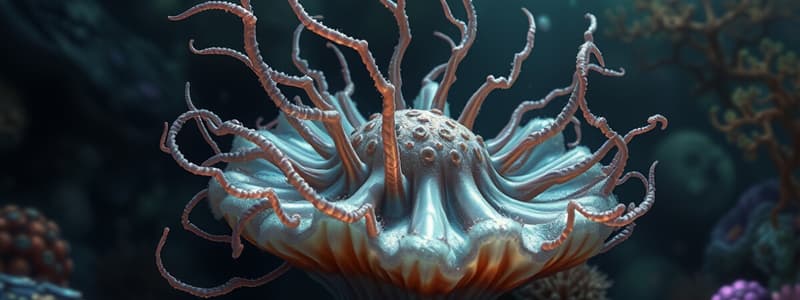Podcast
Questions and Answers
Which of the following characteristics belong to the phylum Cnidaria?
Which of the following characteristics belong to the phylum Cnidaria?
- Gastric pouches
- Cnidocytes (correct)
- Coral skeletons
- Diploblastic (correct)
What are cnidocytes?
What are cnidocytes?
Stinging cells
What is a nematocyst?
What is a nematocyst?
Venomous harpoon
The ______ level of organization in cnidarians includes digestive, nervous, and muscular tissues.
The ______ level of organization in cnidarians includes digestive, nervous, and muscular tissues.
What distinguishes class Hydrozoa from other cnidarian classes?
What distinguishes class Hydrozoa from other cnidarian classes?
The Hydrozoa class has cnidocytes embedded in both epidermis and gastrodermas.
The Hydrozoa class has cnidocytes embedded in both epidermis and gastrodermas.
How do Hydra reproduce?
How do Hydra reproduce?
Which statement is true about class Scyphozoa?
Which statement is true about class Scyphozoa?
What is true about anthozoans?
What is true about anthozoans?
What role do corals play in marine ecosystems?
What role do corals play in marine ecosystems?
Flashcards are hidden until you start studying
Study Notes
Phylum Cnidaria Overview
- Characterized by being diploblastic, consisting of endoderm and ectoderm layers.
- Possess cnidocytes, specialized cells for capturing prey.
- Most species display planula larvae, facilitating dispersal.
Cnidocyte and Cnida
- Cnidocytes are stinging cells used for defense and prey capture.
- Cnida refers to the coiled filament within an inverted tube that can be expelled to deliver sting.
Nematocysts
- A type of cnida, nematocysts are venomous harpoons enabling predation.
Tissue Organization
- Exhibits three tissue types: digestive, nervous, and muscular, allowing for complex functions.
Epidermis and Gastrodermis
- Epidermis has epitheliomuscular cells with longitudinal muscle fibers for contraction.
- Gastrodermis contains nutritive-muscle cells with contractile circular muscle fibers aiding in digestion.
Mesoglea
- A gelatinous layer composed of water and collagen, situated between the endoderm and ectoderm.
Class Hydrozoa Characteristics
- Dominantly polyp form with cnidocytes primarily located in the epidermis.
- Typically very small, with medusa stage having a velum present and no gastric pouches or oral arms.
Hydrozoa Feeding and Digestion
- Hydra utilize gland cells to secrete enzymes for digestion, and nutrients are absorbed by surrounding cells via diffusion.
Hydra Reproduction
- Can reproduce sexually (dioecious with distinct male and female) or asexually through budding, with embryos encysting until favorable conditions arise.
Specimen Obelia in Hydrozoa
- Colonial organism alternating between polyp (hydranth for feeding, gonangium for reproduction) and medusa forms, with both sexual and asexual reproduction.
Specimen Gonionemus
- Medusa form is predominant with distinct gastric canals and sensory capabilities via statocysts and ocelli.
Specimen Physalis
- Portuguese man o' war is a colonial organism comprised of numerous polyps functioning together, featuring structures for floating (pneumatophore) and feeding (gastrozooids).
Class Scyphozoa Characteristics
- Known as true jellyfish, with a dominant medusa form and cnidocytes in both epidermis and gastrodermis.
- Lacks a velum and has amoeboid cells within the mesoglea.
Scyphozoa Specimen Aurelia
- Features four oral arms and a gastrovascular cavity with four folded pouches.
- Exhibits a complete canal network with scalloped bell margin containing sensory rhopalia.
Scyphozoa Reproduction Cycle
- Life cycle includes stages from medusa to zygote, planula larva, scyphistoma, strobila, ephyla, and back to medusa.
Class Anthozoa Characteristics
- Known as "flowers of the ocean," consists solely of polyp forms with septa in the gastrodermis bearing nematocysts.
- Tentacle structures can be either hexamerous or octamerous.
Anthozoa Corals
- Colonial polyps that secrete calcium carbonate skeletons; hard corals are hexamerous while soft corals are octamerous.
Importance of Cnidarians
- Serve as critical habitat for marine biodiversity while also playing a role in food chains, such as turtles and crabs consuming jellyfish.
Studying That Suits You
Use AI to generate personalized quizzes and flashcards to suit your learning preferences.



